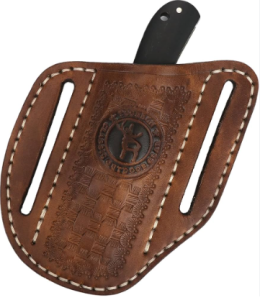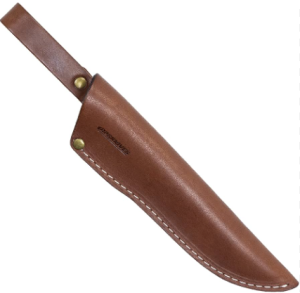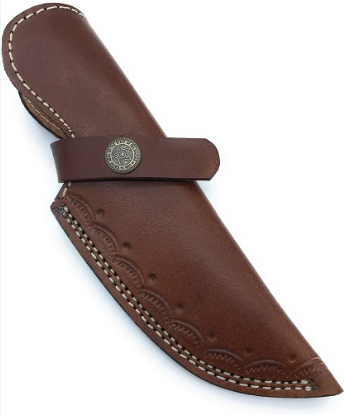Belt Knife Sheath
In the realm of concealed carry and everyday carry (EDC), finding the optimal method to discreetly carry essential tools is a never-ending pursuit. While most discussions around concealed carry revolve around firearms, the significance of having a reliable and accessible knife should not be underestimated. An ankle knife holster presents itself as an ingenious solution, offering both concealment and quick access. In this exploration of the best ankle knife holsters, we delve into the features, advantages, and considerations that make these holsters a valuable addition to any EDC arsenal.
Unveiling Ankle Knife Holsters: A Fusion of Tradition and Innovation
The concept of carrying a weapon on the ankle isn’t a new one. Historical evidence reveals that individuals, ranging from law enforcement officers to civilians, have employed this method to keep backup weapons within easy reach. Today’s ankle knife holsters are a seamless fusion of traditional wisdom and modern engineering, designed to enhance comfort, accessibility, and concealment.
Features that Define Excellence
Secure Retention Mechanism: The hallmark of a superior ankle knife holster lies in its ability to securely retain the knife, ensuring it doesn’t come loose during movement. This is typically achieved through adjustable straps, snap buttons, or hook-and-loop closures that keep the knife in place while allowing for a quick draw when needed.

Comfortable Fit: Ankle holsters need to strike a balance between snugness and comfort. Top-tier holsters often incorporate ergonomic designs and materials that prevent chafing and discomfort during prolonged wear. Ventilation channels or moisture-wicking fabrics also enhance comfort, particularly in warm conditions.
Adjustability: People have different ankle sizes, and an excellent holster accommodates these variations through adjustable straps or multiple size options. The ability to fine-tune the fit ensures that the holster stays in place without being overly restrictive.
Knife Compatibility: Ankle holsters are designed to accommodate specific knife models or types. The best holsters are versatile, capable of housing a range of knife sizes and shapes, from compact folding knives to discreet fixed-blade models.
Concealment and Accessibility: The primary objective of an ankle knife holster is to remain concealed under clothing, while still allowing for quick access to the knife. A high-quality holster keeps the profile slim, preventing printing (visible outline) while offering a swift and smooth draw.

Material Quality: Ankle holsters are subjected to constant friction against the skin and clothing. Holsters constructed from durable and robust materials, such as high-quality nylon or reinforced fabrics, ensure longevity and reliable performance.
Advantages of Ankle Knife Holsters
Subtle Concealment: Ankle holsters offer an unparalleled level of concealment. Unlike waistband holsters, they don’t create bulges or lines on the outerwear, making them an excellent choice for scenarios where complete discretion is desired.
Backup Option: Ankle holsters are often used to carry a backup knife. In situations where accessing a primary weapon might be difficult, having a secondary tool within arm’s reach can be a game-changer.
Non-Interference: Ankle holsters avoid interfering with the upper body, leaving your waistband and upper body area clear for other EDC items like firearms, spare magazines, or communication devices.
Sitting Comfort: Traditional holsters can become uncomfortable when seated for extended periods. Ankle holsters mitigate this issue, as they don’t dig into the waist or obstruct movement when sitting.
Variety of Clothing Options: Ankle holsters can be worn with a variety of clothing styles, including suits, dresses, or casual attire. They adapt well to both formal and informal settings.
Selecting the Perfect Belt Knife Sheath: A Comprehensive Guide
A belt knife sheath is an essential accessory for any outdoor enthusiast or professional who carries a knife regularly. The right sheath not only provides easy access to your knife but also protects you and your gear. With a plethora of options available, choosing the best belt knife sheath can be a daunting task. This guide aims to provide you with valuable insights and tips to help you make an informed decision.
Material and Construction:
Look for high-quality materials such as leather, Kydex, nylon, or molded plastic. Each material has its own advantages; leather provides a classic look and ages well, while Kydex offers excellent retention and durability.
Ensure the sheath is well-constructed and securely holds the knife in place to prevent accidental slips.
Knife Compatibility:
Choose a sheath designed specifically for your knife model. A well-fitting sheath ensures that the knife is secure and doesn’t rattle or fall out.
Check if the sheath accommodates the blade length, handle design, and overall dimensions of your knife.
Attachment Options:
Consider how the sheath attaches to your belt or gear. Common attachment methods include belt loops, clips, and straps.
Opt for a sheath with adjustable attachments that allow you to position the knife comfortably and accessibly on your belt.
Retention Mechanism:
Look for a sheath with a reliable retention mechanism that keeps the knife securely in place while allowing for easy drawing.
Retention options can include snap buttons, straps, friction, or magnetic closures. Choose one that suits your preferences and usage.
Carry Style:
Decide on the carry style that suits your needs: vertical, horizontal, scout, or cross-draw. The chosen style should be comfortable and accessible for your intended use.
Consider if you want the sheath to be ambidextrous or specifically designed for left- or right-handed users.
Additional Features:
Some sheaths come with extra pockets, pouches, or slots for carrying fire starters, sharpeners, or other tools.
Think about any additional functionality you might require and choose a sheath that offers those features.
Durability and Weather Resistance:
If you’ll be using the sheath in rugged environments or adverse weather conditions, prioritize durability and weather resistance.
Look for features such as water-resistant materials, corrosion-resistant hardware, and reinforced stitching.
Aesthetics and Personal Preference:
While functionality is key, the aesthetic appeal of the sheath matters too. Choose a sheath that aligns with your personal style and preferences.
Reviews and Recommendations:
Read customer reviews and seek recommendations from fellow knife enthusiasts or professionals. Their experiences can provide valuable insights into the performance and durability of different sheaths.
Considerations When Choosing an Ankle Knife Holster
Legal Regulations: Before incorporating an ankle knife holster into your EDC, it’s crucial to understand the legal regulations surrounding concealed carry, both for knives and holsters, in your jurisdiction.
Comfort vs. Concealment: Striking the right balance between comfort and concealment is essential. A holster that sacrifices comfort for ultimate concealment might not be practical for everyday use.
Knife Size and Weight: The size and weight of the knife you intend to carry influence the choice of holster. Heavier knives might require sturdier holsters with additional support.
Draw Technique: Mastering the draw technique is crucial for quick and efficient access. Regular practice ensures muscle memory and minimizes fumbling during critical moments.
Conclusion
The evolution of concealed carry tools has given rise to innovative solutions that cater to the needs of modern individuals. Ankle knife holsters exemplify this innovation by providing a discreet, comfortable, and accessible method for carrying essential knives. The best ankle knife holsters seamlessly blend security, comfort, and concealment, empowering individuals to be prepared for any situation without compromising their personal style or comfort. When selecting the ideal ankle knife holster, a balanced consideration of features, advantages, and personal preferences ensures that you have a reliable companion in your everyday journey.
FAQs about the Best Belt Knife Sheath
What makes a belt knife sheath the best choice for carrying a knife?
A: The best belt knife sheath is typically made from high-quality materials that provide durability and secure retention of the knife. It should have a snug fit, preventing accidental slips or falls, and allow for easy access to the knife while ensuring user safety.
What materials are commonly used in crafting the best belt knife sheaths?
A: The best belt knife sheaths are often crafted from materials like genuine leather, Kydex, or durable nylon. Leather offers a classic and natural feel, Kydex provides a rigid and molded fit, while nylon offers lightweight and versatile options with added water resistance.
Are there specific features to look for in the best belt knife sheath?
A: Yes, important features include a secure retention system such as snap buttons, straps, or friction holds. Additionally, a well-designed belt loop or clip ensures stable attachment to your belt, while adjustable positioning and multiple carry options add versatility.
Can the best belt knife sheath accommodate different knife sizes and styles?
A: Many quality belt knife sheaths are designed to accommodate a range of knife sizes and styles. Some may have adjustable retention mechanisms or flexible materials that conform to the shape of the knife, making them suitable for various blades.
How do I choose the best belt knife sheath for my specific needs?
A: Consider factors like the type and size of your knife, your preferred carry style (horizontal or vertical), and the environment you’ll be using it in (urban, outdoor, tactical, etc.). Assess the quality of materials, retention methods, and comfort in wearing. Reading reviews and seeking recommendations can also help guide your decision.
